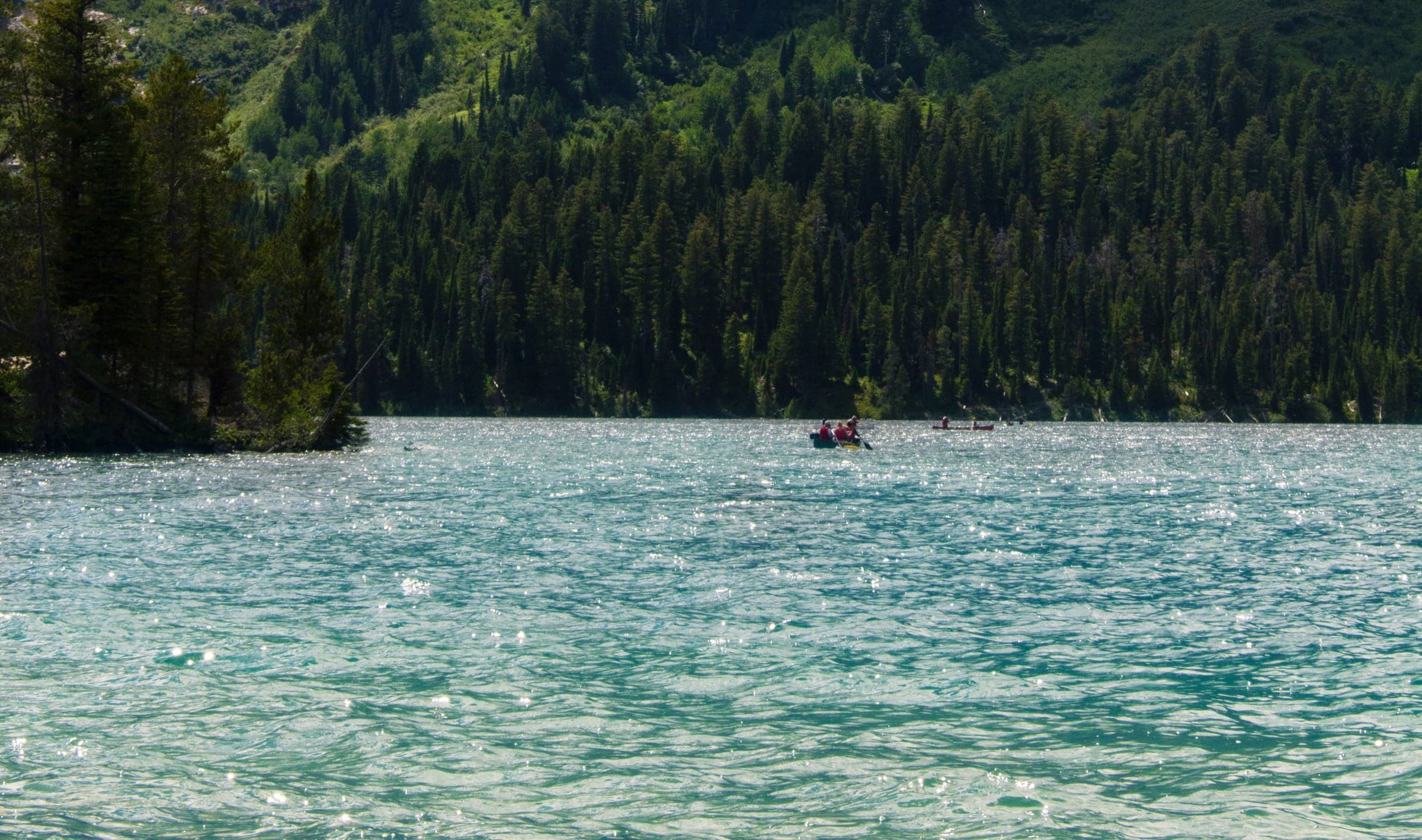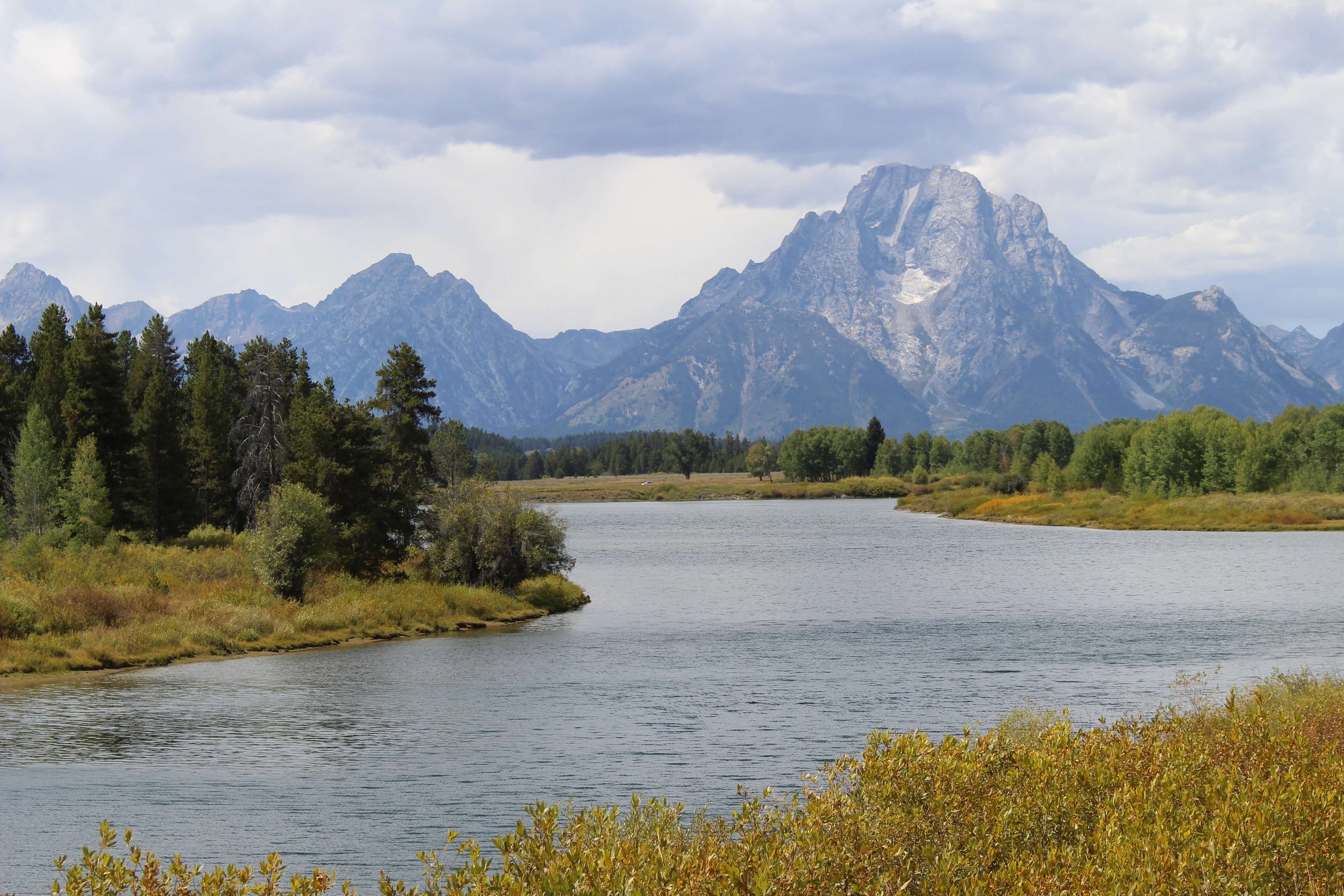GRAND TETON CANOEING


With a tremendous volume of water pouring through the land’s streams and rivers each and every day and over 100 lakes, a Grand Tetons canoeing or kayaking experience is not to be missed. Grand Teton canoeing opportunities are plentiful and well worth the slight hassle of renting equipment, allowing for stunning visuals of the crystal clear lakes flanked by the craggy cliffs, dense forests and wandering meadows that the park is famous for.
The largest lake in the Grand Teton range is Jackson Lake, and given its size, you’ll want to stay informed of local weather conditions while boating out on Jackson Lake. All of the lakes in Jackson Hole allow canoeing, but only Jackson and Jenny Lakes allow motorized boats. Jenny Lake is restricted to 10-horsepower craft, while Jackson Lake has no horsepower restrictions but does have a noise restriction.
Glamping on the Greys offers guided trail rides on our experienced trail horses through some of the most picturesque and ecologically abundant lands in Wyoming. Located in the Star Valley, the mountains and valleys surrounding the Little Grey’s River offer some of the best views in North America. Explore well-known local trails like Pickle Pass, Strawberry Creek Trail, McDougal Pass and the popular Roosevelt Meadows. From beginner-friendly rides to more intensive all-day or pack-trip rides, we cater to those with varying experience levels and ambitions.
The area has a unique variety of terrain to cover, ranging from jagged goat trails up steep mountainsides to expansive valleys and meadows, streams and rivers to ford. Wyoming is a wild place, a place for the adventurous at heart. Many Grand Teton National Park horseback riding trails have lookout points featuring sweeping panoramas of the mountains, their chasms and beyond. The scope and scale of the geology and biology on display here can often have a profound effect on those who behold it.
With so many bodies of water to choose from, it can be difficult to know where to head first. Grand Teton is well supplied with roads and parking lots that make launching into the lakes and streams easy for paddlers. The guides at Glamping On The Greys can direct you to the perfect place for the kayaking experience you are looking for and help you choose amongst the local kayak rental options. The waters in Grand Teton contain rapids up to class IV, and there are many mellow floats for people who want a more relaxing experience.
The largest of the area’s lakes is Jackson Lake. It is 15 miles long by 7 miles wide and has a depth of 438 feet. Because of Jackson Lake’s large size, the water may become quite choppy at times, and in the event of these unfavorable conditions, paddlers are advised to use the smaller, more sheltered bays of Half Moon Bay and Colter Bay. The sheer size of Jackson Lake and the opportunities this provides for additional watersports like sailing, windsurfing and water skiing make it one of the very best places to do some Grand Teton canoeing. A multi-day excursion here will be fun, with islands to explore and hiking trails nearby to explore. It originated as a natural glacial lake, but today, it is a reservoir that provides water storage for irrigation. Jackson Lake is an extremely popular lake for fishing and the lake trout here have been known to grow to monstrous proportions.
To get to String Lake, take the Teton Park Road and turn at North Jenny Lake junction. Follow signs for String and Leigh lakes. String Lake has no kayak rentals, so if you want to experience kayaking here, you’ll have to rent one elsewhere – they offer them at the shops in Jackson – or bring your own. That being said, it’s worth making the drive here.
String Lake has a boat launch with shallow, warm water, picnic areas and nice sandy beaches. You won’t have trouble relaxing with your companions. There are numerous hiking trails around the area of String Lake and nearby Leigh Lake that go into Paintbrush Canyon and beyond.
Named after Richard “Beaver Dick” Leigh, one of the area’s last true mountain men, Leigh Lake can be accessed by first paddling through String Lake and then passing through a 200-foot portage to re-enter the water into Leigh Lake. Because of the portage, Leigh Lake is much less populated than String Lake, and you’ll likely be alone on the water. If you want your Grand Teton canoeing to be supremely tranquil, visiting Leigh Lake is well worth the extra effort.
One of the most famous lakes in Grand Teton National Park is Jenny Lake. It is also one of two lakes in the area that allows motorized boats. Referred to as the centerpiece of the park, Jenny Lake boasts some of the most stunning visuals of Grand Teton’s raw, sprawling landscape. With views of Teewinot Mountain, Mount St. John, and Cascade Canyon from the East shore and the valley of Jackson Hole from the West shore, it is a spectacular vantage point to soak in the splendor of mother nature. The South side of the 5-mile-long lake is where the visitor center, boat rental and busier areas are. The North side is a bit quieter, with a smaller parking lot and boat launch. If you want to go kayaking in Wyoming, don’t miss out on Jenny Lake!
The legendary Snake River flows through Grand Teton National Park and provides some of the park’s most quintessential Grand Teton canoeing opportunities. Any non-motorized boat is permitted in the Snake River. However, the tributaries and streams that are offshoots of the main lake do not allow boating of any kind. There are two areas along the Snake River to find a more thrilling whitewater experience, Additionally, on the Gros Ventre River, you’ll find thrilling whitewater. Along the Snake River, you’ll find the best fishing in Grand Teton National Park for Fine Spotted Cutthroat Trout. To go fishing in Grand Teton National Park, you’ll need a fishing license and conservation stamp, easily obtained through the Wyoming Game & Fish Department or at a local shop.

A tributary of the Snake River, the Greys River begins about 45 miles south of Alpine, high in the Wyoming Range. It flows into the Snake River in Snake River Canyon, just east of Alpine. With a fair amount of rapids in the class III or class IV range, the Grey’s River is recommended for intermediate kayakers. The Greys River has numerous tributaries woven throughout the range, one of which is Little Greys River, which flows through Glamping On the Greys and provides ample opportunities for fishing, canoeing and kayaking in Grand Teton National Forest.
The water flowing in the Little Greys River originates near Hobock Peak and extends for nine miles through the picturesque scenery of the Star Valley and Alpine before becoming absorbed by the Greys River. It joins the Snake River just above the intersection of U.S. highways 89 and 26, then winds its way through Idaho and into Portland before being carried into the ocean as part of the Columbia River. There are many parts along the Little Greys River that are perfect for canoeing, and the slow-moving water makes for a peaceful Grand Teton canoeing trip.
Bailey Lake can be accessed directly from camp via a short ride or hike. This lake is a great size for swimming, fishing, kayaking, paddle boarding and canoeing. There is also a rope swing to take a crack at.
Renting a canoe or Kayak in Grand Teton National Park is easy. Most of the larger lakes have rental shops nearby and boat launches. The majority of canoe rentals have a 2-hour minimum and the cost is around $45. If you are in Grand Teton National Park, there is a canoe and kayak rental shop right at the boat dock on Jenny Lake. Rendezvous River Sports in Jackson rents Kayaks, canoes, and paddle boards that you can strap on the hood of your car and launch into the lake. Switch it up if you’re feeling adventurous!
All kayaking in the Grand Tetons requires a permit. One can be obtained at the Moose or Coulter Bay visitor centers or through the National Park Service website.
Whenever you’re out on the water, you should always maintain good safety procedures. Always make sure you have one personal floatation device (PFD) per person on board; Wyoming State Law says that children must wear one at all times the boat is underway. Make sure you have gear appropriate for whatever type of water you intend to be paddling in. A larger lake, such as Jackson Lake, can be subject to weather conditions, so be aware of the weather forecast when you are out boating in the larger lakes. Most of the park’s waters are open for canoeing and kayaking between mid-May to mid-September.
With 44 named and countless unnamed lakes dotting the landscape and a network of rivers and streams dividing it, one of the best ways to explore Grand Teton National Park is by water. Let the current carry you through the park’s natural gorges and past the breathtaking mountains.
There are soft, mellow streams to float peacefully down and there is rapid whitewater for thrill seekers. There are just as many activities to do on land as there are in the water of the Grand Tetons! As with all of the areas within and around the Bridger Teton National Forest, it’s important to have a no-trace policy and leave the area as pristine as it was when you arrived. Contact Glamping on the Greys to see our availability for your next Grand Teton Canoeing trip.